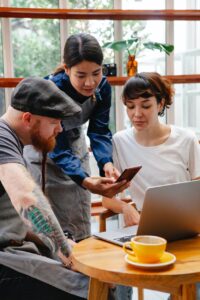A guide to Continuous Performance Management (CPM)
Empower your employees to Grow, Develop, and Succeed.
Modernise your Performance Reviews
Assessing the performance of an organisation’s staff is an important task for managers and HR professionals. The continuous approach to this entails a much more involved and regular process that has certain benefits. Understanding the benefits and methodology of continuous assessment can help determine if it’s the right approach for your workplace. In this blog, we explain what continuous performance management is, describe how you can implement it, list a few of its key benefits and answer some frequently asked questions.
What Is Continuous Performance Management?
If you want to manage performance continually, there are several steps and best practices that you might employ. Many of these are mutually compatible and reinforce each other, allowing you to find the best approach for the organisation at which you work. Here are some steps and best practices to consider:
1. Hold regular check-ins
Regular check-in is one of the simplest and most straightforward ways of starting a continuous performance assessment programme. To do this, team leaders simply have regular check-ins with their team members to check on their progress, discuss what they’re finding difficult and allow them to ask questions. This tends to encourage open communication between leaders and team members, allowing the former to make decisions to improve performance quickly. You could either formally implement this with regular appointments once a week or do it more informally with a broad aim to check in with everyone over the period of every week. You can also try out different lengths of time for the check-ins, although it may be unnecessary to have long weekly check-ins due to how frequent they are. Alternatively, a longer interval between check-ins can be more practical in larger organisations, such as once every month or every quarter.
2. Review objectives
Another key element of continuous performance reviews is to set clear objectives and regularly review progress towards them or their completion. Check-ins can be a good opportunity to do this. This means you can include and review both short and long-term objectives. When these objectives have clear deadlines, your reviews are going to allow you to better assess the productivity of the team member in question over time. This can be beneficial for assessing their workload and whether it’s too much, too low or just enough. It’s useful if the manager and staff member communicate their concerns and ideas regarding objectives. The staff member in question can voice any concerns, and their supervisor can give constructive feedback.
3. Implement observation
Observation is the part of the process between meetings where the supervisor or manager sees what their team members are doing without directly interacting. This can mean taking notes about behaviours and patterns they notice, getting feedback about staff from customers or clients, comparing what they see against organisational guidelines and speaking to colleagues. A useful addition could be the use of self-assessment forms. Observation is useful because it allows supervisors to see the effectiveness of their regular check-ins, evaluate progress and ensure that the new continuous performance system is fair to all staff. This can be particularly important when you’re first implementing a continuous approach to performance management.
4. Provide training and development
One of the primary aims of continuously reviewing staff performance is to identify training and professional development requirements. The combination of regular interaction and observation means that you can identify training needs early and quickly assess their effectiveness. You can also evaluate the quality of the training, how quickly staff adopt what they’ve learned and get relevant feedback. A good way of organising training and making the right choices is to align training programme selection with the short and long-term objectives of staff.
5. Collect feedback
Making the transition to continuous assessment of performance can take some time and adaptation. It’s unlikely that two separate organisations would make the exact same choices for implementing this approach, so a little trial and error is likely and can be a valuable learning experience. Getting feedback over time is an integral part of this process, both from the organisation’s staff and the leaders or managers who are implementing it. In addition to feedback, data that reveals changes in productivity and output can be a valuable tool for assessing the new approach.
Need help with your Performance Management Framework then please do get in touch with us.














